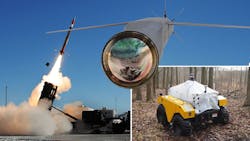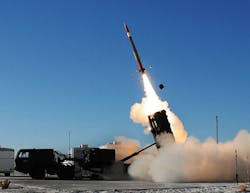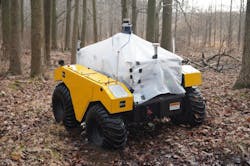Smart Weapons Form Thinking Battlefields
Download this article in PDF format.
What you’ll learn:
- Why smart weaponry is so critical on the modern battlefield.
- How ongoing initiatives from prime contractors will up EW games.
- How smart countermeasures will reduce response times to attacks.
Modern battlefields are immersed in electronic devices and data, whether on the ground, at sea, or in the air. The amounts of data from well-established systems and technologies such as radar, sonar, and LiDAR are becoming too much for any warrior to process, encouraging the development of semi-autonomous or “smart” weapons that can share in the decision-making.
Equipped with artificial-intelligence (AI) and machine-learning (ML) technologies, many of these weapons are guided by light, sound, or electromagnetic (EM) waves to reach a selected target with high accuracy. In addition, smart weapons can be programmed to filter unwanted signals in multiple-signal environments and find a specific target on a battlefield with many potential targets.
Electronic warfare (EW) has long relied on the development of novel technologies such as LiDAR and radar, typically to gain an edge over an adversary or provide advanced warning of an adversary’s actions. Smart military-guidance systems once referred to steering by Global Positioning System (GPS) satellite signals. However, operations that take place in areas in which GPS signals aren’t available, or are being jammed by an adversary, require alternative guidance based on available AI and ML technologies.
Smart weapons and guidance systems use AI and ML empowered by embedded computers to “share” some of the decision-making concerning a response with their human controllers. Weapons in which human guidance is still required are known as semi-autonomous devices. Ultimately, organizations such as the Defense Advanced Research Projects Agency (DARPA) and the U.S. Army Combat Capabilities Development Command Armaments Center (CCDC) are developing different types of smart weapons with an eye toward fully autonomous versions that can make a decision on a strike or respond on their own.
DARPA recently announced that six teams will receive funding as part of the Next-Generation Nonsurgical Neurotechnology (N3) program to develop technology for two-way communication between human brains and machines without requiring surgery. The program assumes that humans, overwhelmed by the amount of data received on the battlefield, would have AI-powered machines as partners and require almost instantaneous response times.
Humans now suffer delays in decision-making with machines due to the way the nervous system interacts with machine microprocessors. The program would explore the use of viral vectors or viruses that carry proteins into the brain for detection of light from neurons. By detecting the activity of neurons, it may also be possible to determine a human’s thoughts and thought processes for faster interaction with AI-driven systems.
A government-appointed panel has reviewed the benefits and risks of smart weapons on the battlefield. The independent National Security Commission on Artificial Intelligence (NSCAI), created in 2018, recently completed a 130-page draft report that’s scheduled for submission to the U.S. Congress this month. It recommends the use of AI and ML technologies for military use, noting that AI-enabled weapons are expected to make fewer mistakes than human combatants and can play a vital, positive role in national security.
The panel was led by Eric Schmidt, the former chief executive of Google. It was opposed by a coalition of non-governmental organizations and 30 countries that has pushed for a treaty banning smart weapons on the grounds that human control is necessary for the ethical management of the battlefield.
Future battlefield strategies are being planned with AI as a vital component in analysis of battlefield situations on land, at sea, and in the air. AI will be used as part of embedded EW systems to provide augmented-reality (AR) information to operators.
The AR data will be collected by many different battlefield sensors, such as those aging radar and LiDAR systems. It will be presented on different forms of displays to human soldiers and/or smart electronic weapons systems that will be programmed to respond to the inputs via actions that include identifying threats as well as friendly troops, classifying threats, and prioritizing targets.
The Path to Autonomy
Systems currently called smart weapons are limited in their autonomous capabilities, although the use of AI and ML technologies is expected to increase significantly within the next decade. The concept of computing machines for the battlefield isn’t new. In fact, it’s been in development since the aftermath of World War II with the creation of tables of firing statistics that were analyzed and used to increase the targeting accuracy of ballistic missiles.
Military system designers are planning for three levels of AI: artificial narrow intelligence (ANI) with limited decision-making capabilities for specific tasks; artificial general intelligence (AGI) with decision-making capabilities that can match human intelligence for any task; and artificial superintelligence (ASI) with decision-making capabilities that exceed human intelligence for any task.
Although the vision of many system planners is for fully autonomous weapons operating without supervision, many applications will require advanced human-machine training and interaction. The use of multiple robotic systems is one such case.
For example, it might apply to remote direction of a “flock” of miniature unmanned aerial systems (UAS) for surveillance purposes, or when miniature drones armed for attack must be guided to a target and detonated. This need for a reliable, remote man-machine interface under battlefield conditions emphasizes the importance of military-grade communications networks capable of handling large amounts of data under hostile operating conditions, including cyberattacks.
Increasing Effectiveness
A starting point for many smart weapons is the application of AI and ML to EW systems for improved performance, such as increased targeting range and accuracy. Northrop Grumman Corp. was recently contracted by DARPA’s Tactical Technology Office (TTO) for an advanced technology weapon capable of much greater range and accuracy than current systems when deployed against airborne threats.
General Atomics and Lockheed Martin also received contracts as part of the first phase of the program. Appropriately named LongShot, the program will leverage the contractors’ expertise in AI and digital signal processing (DSP) to develop new lethal-engagement concepts for unmanned aerial systems (UAS) powered by multiple propulsion systems, capable of being deployed by bombers as well as much smaller fighter aircraft. The LongShot system is being designed for external transport on fighters and internal transport on bombers.
According to Jaime Engdahl, the program director for kinetic weapons and emerging capabilities at Northrop Grumman, the development of smart weapons is a necessary response to the growing number of robotic and autonomous threats. He said, "Our collaboration with DARPA is the critical first step in the development of innovative operational concepts and solutions that will enhance our warfighter's combat capability against a rapidly growing threat."
Concerning LongShot, Engdahl added, “The LongShot program enables us to combine our digital engineering skillset with our extensive knowledge in advanced technology weapons, autonomous systems, and strike platforms to increase weapons range and effectiveness.”
The pairing of Lockheed Martin’s Long-Range Anti-Ship Missile (LRASM) and BAE Systems’ missile seeker technology also combines AI techniques with sensor fusion to steer the missile over distances as far as 200 nautical miles. The system has been in production for several years. It was initially part of a joint project by DARPA, the U.S. Navy (USN), and U.S. Air Force (USAF) to create an anti-ship missile that could launch from a USN F/A-18E/F Super Hornet fighter/bomber or USAF B-1B Lancer bomber. As GPS-jamming capabilities have increased among adversaries, demand for the LRASM has grown—a weapon that can cover long distances without relying on GPS, using the LRASM’s on-board radar and semi-autonomous guidance systems.
Thinking Through Weather
Current intelligent weapons systems often use AI and ML to enhance operation under adverse conditions, such as the aptly named StormBreaker from Raytheon Technologies and its Raytheon Missiles & Defense division. The smart weapon (Fig. 1) is designed to destroy moving targets despite the worst weather conditions. It autonomously detects and classifies moving targets in darkness, bad weather, through smoke, and even in the dust stirred up by helicopters over a battlefield.
StormBreaker’s built-in intelligence is aided by a multimode seeker with a host of powerful sensors, including a millimeter-wave radar system, an infrared (IR) imaging system to differentiate targets from friendly forces in foul weather, and a semiactive laser system that can track ground-based or airborne targets. Because the data from the seeker’s multiple sensors are shared, the system can accurately identify and track fixed or moving targets even under the most challenging environmental conditions.
The StormBreaker system is extremely compact, allowing fighter jets to carry multiple systems. An F-15 fighter jet can carry seven groups of four StormBreaker smart weapons or a total of 28 munitions systems. The system provides high precision so that explosions are kept within a small footprint.
StormBreaker also is intelligent, with a high-speed data link that allows a fighter pilot to interact with the smart weapons system and change targets even as the weapon is gliding to the ground toward its initial target. The system has been approved for use on the F-15E fighter, and the U.S. Air Force and Navy have begun integration of StormBreaker systems into F-35 Joint Strike Fighter (JSF) and F/A-18E/F Super Hornet fighter aircraft.
As part of smart-weapons systems, AI and ML technologies can be used for guidance, intelligence collection, surveillance, and in some cases, as part of electronic countermeasures (ECM) responses to an adversary’s AI-guided robotic systems. For example, Boeing has been working with Lockheed Martin on the development of a next-generation seeker for the U.S. Army’s Patriot Advanced Capability-3 (PAC-3) missile system while continuing production of current generations of the PAC-3 seeker. The seeker is a key component in the guidance system of the PAC-3 missile system (Fig. 2), used as a defense against enemy aircraft, tactical ballistic missiles, and cruise missiles.
Defending against autonomous threats is considered an essential part of future battlefield planning. On that front, Boeing recently upgraded its directed-energy weapon, the Compact Laser Weapon System (CLWS) for a U.S. Department of Defense (DoD) customer. The upgrades include increased beam power and reliability for situations involving growing numbers of larger unmanned aerial vehicles (UAVs) on the battlefield.
Kurt Sorenson, Boeing program manager for CLWS, explains, "The upgraded units will provide warfighters with enhanced protection against larger and more numerous hostile unmanned aircraft systems. They will also enable them to defeat threats more quickly and efficiently." The CLWS has proven successful against UAVs in numerous exercises requiring target acquisition and tracking of multiple moving miniature aircraft.
Intelligent Countermeasures
One aspect of learning to fight alongside smart weapons is effective integration within a working battlespace and not discarding current systems for the sake of “more intelligent” ones. The Smart D2 system from BAE Systems is an automated threat-management system designed for integration into current and future ECM systems. It provides AI, secure communications, and automation in the form of core components such as a programmer, sequencer, and dispenser. The programmer features a regularly updated database of threats and can identify optimum payloads, quantities, and dispensing intervals of weapons used for each ECM response.
The Smart D2 system incorporates NATO’s standard Smart Stores Communication Interface (SSCI) for communication between dispenser system and smart ECM systems, and provides two-way communication of mission-critical information for human pilots to make their own decisions about appropriate ECM responses (Fig. 3). A Smart D2 System can be integrated into an aircraft’s ALE-47 Airborne Countermeasures Dispenser System. Instead of replacing an ALE-47 system, its main elements are swapped out for Smart D2 elements.
On the ground, the U.S. Army Research Laboratory recently expanded its Robotics Research Collaborative Campus (R2C2) north of Baltimore, Md. to evaluate unmanned ground vehicles (UGVs) and terrestrial smart weapons. The Aberdeen Proving Ground uses about 200 acres for testing of ground-based systems (Fig. 4) and simulation of battlefield conditions for the use of AI-driven robotics systems.
The in-field testing follows computer-based simulations of UGVs, providing test data based on a realistic operating environment. Both hardware and software, such as the ARL Autonomy Stack of algorithms, can be checked in the outdoor laboratory to evaluate such effects as frequency and erratic terrain changes and large obstructions. The test results help develop ML solutions for future performance improvements in the UGVs.
Thinking machines and smart weapons may be some years away from sharing a battlefield with human combatants. Nonetheless, major defense organizations such as DARPA and the DoD are committed to the development of weapons leveraging AI and ML technologies capable of sharing with decision-making processes in data-dense environments.
The growing use of small UAVs or drones, for example, can create extremely hazardous operating environments where human warriors with conventional weapons lack the necessary firepower to defend against swarms or hordes of robotic adversaries. A generation of human warriors raised on video games may find that reality is starting to resemble those games.
About the Author
Jack Browne
Technical Contributor
Jack Browne, Technical Contributor, has worked in technical publishing for over 30 years. He managed the content and production of three technical journals while at the American Institute of Physics, including Medical Physics and the Journal of Vacuum Science & Technology. He has been a Publisher and Editor for Penton Media, started the firm’s Wireless Symposium & Exhibition trade show in 1993, and currently serves as Technical Contributor for that company's Microwaves & RF magazine. Browne, who holds a BS in Mathematics from City College of New York and BA degrees in English and Philosophy from Fordham University, is a member of the IEEE.




